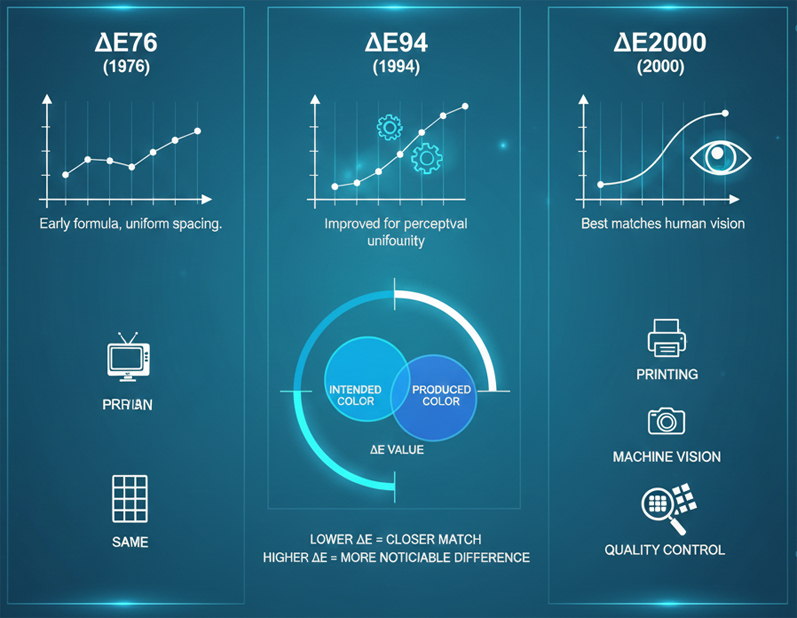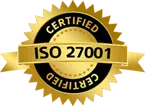A Detailed and Educational Guide for Color Science, Printing, Manufacturing, and Machine Vision
Color quality control depends on measuring how different two colors are—the color you intended vs. the color you produced. To quantify this, the color science community uses ΔE (Delta E) values. ΔE tells you:
How far apart two colors are in human perception.

The lower the ΔE value, the closer the match. The higher the ΔE, the more noticeable the difference.
Over time, scientists created several ΔE formulas to better match the way humans see color. The most widely used versions today are:
ΔE76 (1976)
ΔE94 (1994)
ΔE2000 (2000)
This article explains each version, why new formulas were introduced, and where they are used in modern manufacturing and machine vision—especially systems like Intelgic’s Color Shade & Design Matching Inspection.
What Is ΔE?
ΔE (Delta E) means “Delta Error” or “Difference in Color”. It compares two colors in CIELAB color space, where a color is defined by three values:
L*
Lightness
a*
Green–Red axis
b*
Blue–Yellow axis
ΔE is essentially the distance between two points in this 3D space.
Why Do We Need Different ΔE Formulas?
Human eyes do not perceive all color differences equally. For example:
- A small difference in yellow may be obvious
- The same difference in blue may be barely noticeable
Earlier ΔE formulas didn’t account for these perceptual variations. So new versions were introduced to make color difference measurements more human-aligned.
ΔE76 (CIE 1976) – The Original Formula
Definition
ΔE76 is calculated using simple Euclidean distance in CIELAB:
\Delta E_{76} = \sqrt{(L_2-L_1)^2 + (a_2-a_1)^2 + (b_2-b_1)^2}
Advantages
- Simple
- Easy to compute
- Good for basic color comparison
Limitations
- Not perceptually uniform
- Overestimates differences in some colors
- Underestimates differences in others
- Not ideal for high-precision applications
Use Cases
- Basic color comparison
- Legacy systems
- Quick approximations
ΔE76 is now considered outdated for professional color inspection.
ΔE94 (CIE 1994) – Improved for Industry Needs
To fix ΔE76’s inconsistencies, CIE introduced ΔE94.
Key Improvements
Adds weighting factors for:
Because human eyes are more sensitive to some differences than others.
Formula (simplified)
\Delta E_{94} = \sqrt{\left(\frac{\Delta L}{k_L S_L}\right)^2 + \left(\frac{\Delta C}{k_C S_C}\right)^2 + \left(\frac{\Delta H}{k_H S_H}\right)^2}
Where:
S_L, S_C, S_H= scaling factorskconstants = industrial parameters
Advantages
- More accurate than ΔE76
- Better suited for print and textile industries
- Closer to human visual perception
Limitations
- Still not perfect
- Struggles with blue and neutral colors
- Does not handle rotation of hue well
Use Cases
ΔE2000 (CIEDE2000) – The Most Accurate Modern Standard
Released in 2000, ΔE2000 is the state-of-the-art formula for color difference measurement. It corrects several issues in ΔE94.
Key Improvements
- Corrects hue differences (especially blue region)
- Adjusts for neutral colors (grayish tones)
- Better perceptual uniformity
- Handles lightness, chroma, and hue interactions
- Introduces a rotation term R_T for more accuracy
Simplified Formula
The full formula is complex, but conceptually:
\Delta E_{2000} = \sqrt{\Delta L'^2 + \Delta C'^2 + \Delta H'^2 + R_T(\Delta C')(\Delta H')}
Advantages
- Most accurate human-aligned ΔE formula
- Widely adopted in modern industries
- Ideal for automated color inspection
- Best for tight tolerance manufacturing
Limitations
- Computationally heavier
- Requires more parameters
- Not suitable for very simple systems
Use Cases
How to Interpret ΔE Values (Perception Scale)
| ΔE Value | Perception |
|---|---|
| ≤ 0.5 | Not perceptible by human eye |
| 0.5 - 1.0 | Perceptible through close observation |
| 1.0 - 2.0 | Perceptible at a glance |
| 2.0 - 5.0 | Clear difference in color |
| > 5.0 | Colors appear different |
| > 10.0 | Completely different colors |
Industry Tolerance Standards
- ΔE ≤ 1.0 for logos or brand-critical colors
- ΔE ≤ 2.0 for background or non-critical areas
- ΔE ≤ 3.0 for textiles and natural variations
Why ΔE Matters in Manufacturing and Quality Control
1. Ensuring Brand Consistency
Brands require exact color reproduction across millions of units.
2. Reducing Customer Complaints
Subtle color errors are often the biggest cause of returns.
3. Objective, Repeatable Measurement
Unlike human inspection, ΔE is scientific and consistent.
4. Enables Automated Inspection
Machine vision systems rely on ΔE2000 for precise QC.
5. Cross-Industry Standardization
ΔE allows different factories, printers, and suppliers to speak the same color language.
Why Intelgic Uses ΔE2000 by Default
Intelgic’s Color Shade & Design Matching Inspection system uses ΔE2000 for most applications because:
- It best matches human color sensitivity
- It provides more accurate rejection decisions
- It avoids false negatives/false positives
- It works well across materials (textiles, packaging, ceramics)
- It remains reliable under changing conditions
Note: For customers who need legacy support, Intelgic also provides ΔE76 and ΔE94 options in recipes.
Comparing ΔE Versions: Summary Table
| Feature | ΔE76 | ΔE94 | ΔE2000 |
|---|---|---|---|
| Year | 1976 | 1994 | 2000 |
| Perceptual Accuracy | Low | Medium | High |
| Industry Use Today | Low | Medium | High |
| Computes Lightness | Yes | Weighted | Highly refined |
| Handles Hue Differences | Poor | Better | Best |
| Suitable for Machine Vision | Limited | Good | Excellent |
| Complexity | Simple | Medium | Complex |
Final Thoughts
Color quality is no longer subjective or reliant on human eyes. ΔE formulas provide a scientific, standardized, and global way to measure how colors differ.
ΔE76
Simple but outdated
ΔE94
Improved but limited
ΔE2000
The modern gold standard for precision
Whether you are in printing, packaging, textiles, automotive, or industrial manufacturing, understanding these ΔE metrics is crucial for achieving consistent, high-quality color reproduction.
If you’re implementing automated color inspection, ΔE2000 should be your primary metric for accuracy and reliability.


